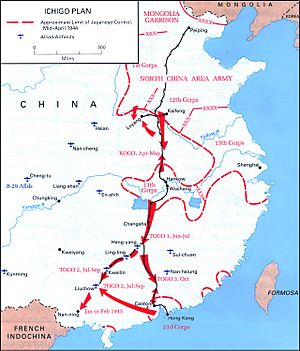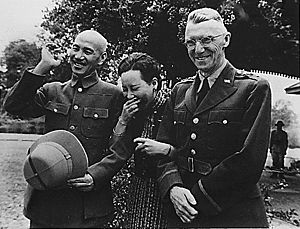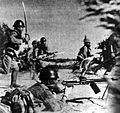Operation Ichi-Go facts for kids
Quick facts for kids Operation Ichi-Go |
|||||||
|---|---|---|---|---|---|---|---|
| Part of Second Sino-Japanese War | |||||||
 Japanese plan for Operation Ichi-Go |
|||||||
|
|||||||
| Belligerents | |||||||
National Revolutionary Army |
|||||||
| Commanders and leaders | |||||||
| Strength | |||||||
| 390,000 men | 510,000 men 15,500 vehicles 1,500 artillery pieces 800 tanks 70,000 horses |
||||||
Operation Ichi-Go (which means "Operation Number One") was a series of big battles. They took place between the armies of Japan and China. These battles happened from April to December in 1944.
The fighting happened in three Chinese provinces: Henan, Hunan, and Guangxi. Japan's main goals for Operation Ichi-Go were:
- To create a route (a clear path) to French Indochina (which is now Vietnam, Laos, and Cambodia).
- To capture air bases that American bomber planes were using. These planes were flying from China to attack Japan and its ships.
Contents
The Campaign Begins
Operation Ichi-Go had two main parts. In the first part, the Japanese army wanted to control the railway line. This railway connected Beijing and Wuhan.
In the second part, they aimed to destroy the US air forces in Hunan province. They also wanted to reach the city of Liuzhou. Liuzhou was close to the border with Indochina, which Japan already controlled.
About 400,000 Japanese soldiers took part in Operation Ichi-Go. They had 12,000 vehicles and 70,000 horses. The Japanese army included very well-trained units. These units came from places like Manchukuo, North China, and Japan itself. This was the largest land operation Japan carried out during the Second Sino-Japanese War.
Many of the new Chinese army units were trained by Americans. But at this time, they were fighting in Burma. They were led by General Joseph Stilwell. They used weapons that the United States had lent to China.
Battle for Luoyang
One important part of the operation was called Operation Kogo. Here, 390,000 Chinese soldiers defended the city of Luoyang. They were led by General Tang Enbo.
In late April, the Japanese 3rd Tank Division crossed the Yellow River near Zhengzhou. They defeated the Chinese forces near Xuchang. Then, they moved to surround Luoyang. Three Chinese divisions defended Luoyang. The Japanese 3rd Tank Division began its attack on May 13. They captured Luoyang on May 25.
Moving South
The second part of Operation Ichi-Go started in May. Japanese forces moved south. They took control of several cities, including Changsha, Hengyang, Guilin, and Liuzhou.
By December 1944, Japanese forces reached French Indochina. This completed their main goals for the operation.
However, the US air forces were smart. They moved their planes and equipment further inland. This meant they were safe from the Japanese attacks on the coastal bases. The US Air Force also often bombed the railway line. This was the line between Beijing and Liuzhou that the Japanese had worked hard to secure. Japan continued to attack airfields where US planes were based until the spring of 1945.
American B-29 bombers, like the ones attacking Japan, also had to move. But this only slowed them down for a short time. In early 1945, these bombers moved to new bases. These new bases were on the Marianas.
What Happened Next
The Chinese army's failure to hold the coastal airfields caused problems. It led to a loss of trust in General Joseph Stilwell by Chiang Kai-shek, the leader of China. Because of this, President Roosevelt replaced Stilwell in October 1944.
The new leader of US forces in China was Major General Albert Wedemeyer. Stilwell's other jobs in China, Burma, and India were given to other officers.
There were disagreements between General Stilwell and Chiang Kai-shek. Stilwell wanted the Chinese armies to fight the Japanese more directly. He also tried to work with other Chinese fighting groups. But Chiang Kai-shek was worried about these other groups. He thought they were a threat to his power.
A reporter named Brooks Atkinson wrote about this time. He said that the decision to remove General Stilwell showed that Chiang Kai-shek's government cared more about staying in power than fighting Japan. He also mentioned that other Chinese groups were fighting the Japanese.
However, another magazine, Time Magazine, offered a different view. It said that the Chinese army was very tired after seven years of fighting Japan mostly alone. They were not eager to send more troops to Burma, as Stilwell wanted. They worried that Japan might attack them even harder. When Japan started its big push (Operation Ichi-Go), the Chinese government might have felt that being careful with their troops was the right choice.
This loss of airfields and the disagreements caused Americans to lose some trust in the Chinese troops. Because of this, the U.S. decided to focus most of its efforts on fighting Japan by moving from island to island across the Pacific Ocean.
Images for kids
See also
 In Spanish: Operación Ichi-Go para niños
In Spanish: Operación Ichi-Go para niños





